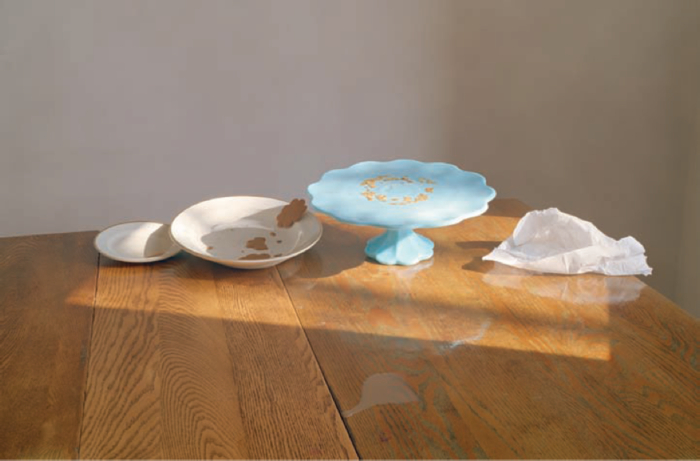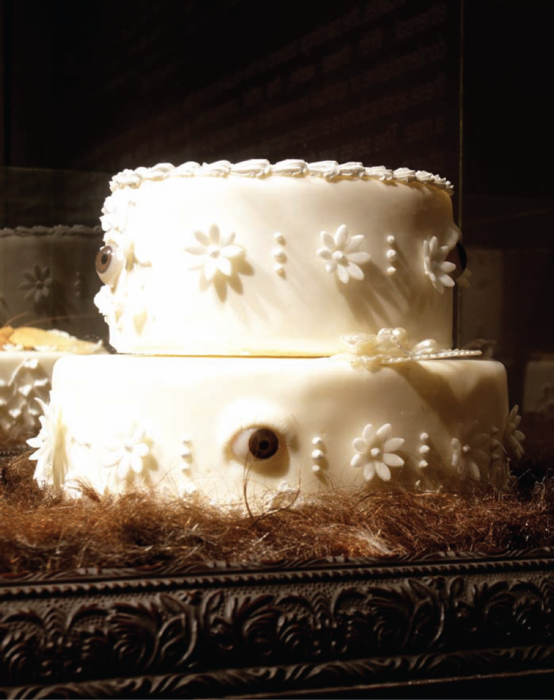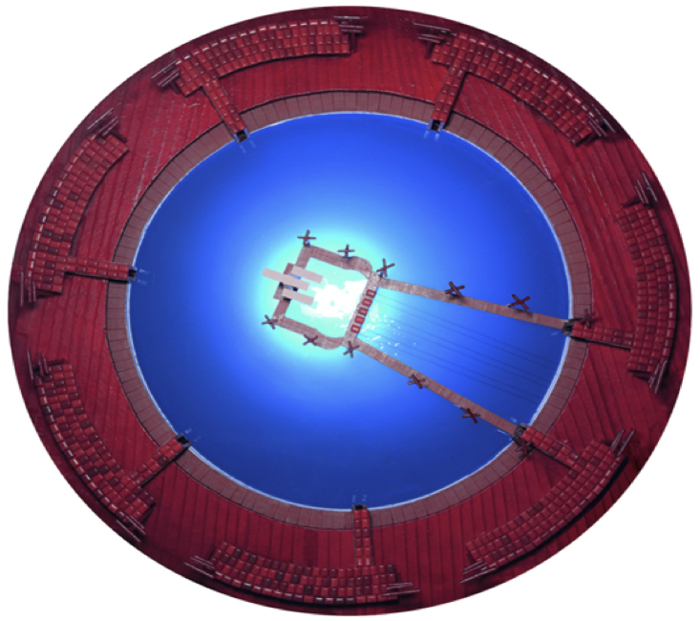Corps de l’article
Artists
Shelley Adler, Dean Baldwin, Suzanne Caines, Larry Glawson, Melanie Gordon, Colwyn Griffith, Fiona Kinsella, Laura Letinsky, Kelly Mark, Chris Shepherd, and Cole Swanson.
What do you call an exhibition of artworks that explores our relationships to food and to each other without mentioning the overused F-word? You borrow the memorable title of an iconic film, and you find a way to express it visually. The invitation to Tara Marshall’s 2011 exhibition at the Art Gallery of Mississauga near Toronto featured four icons: a hamburger, a beverage cup with straw, a male figure, and a female figure, a clever rebus for Eat Drink Man Woman.[1]
This is of course the title of the 1994 Ang Lee film. The film focuses on the relationships between a father, a widower and chef who has lost his ability to taste, and his grown daughters, who are desperate for independence. As Marshall notes in her curatorial statement, the gorgeous but sometimes less-than-tasty food that the father ritually prepares each Sunday becomes a metaphor for the broken lines of communication within the family. Food plays a supporting role, providing context, symbolism and sensuousness, not only subtext but also context for the story being told.
Food, as Ang Lee demonstrated, is an expression of our way of being in the world. It is also, as the very existence of this journal demonstrates, a subject of increasing public and scholarly interest. When the Art Gallery of Mississauga asked Marshall to guest-curate an exhibition on food, she knew that food was a hot topic and the subject of a number of previous and existing exhibitions and installations (The Art of Food at Emily Carr Institute, Vancouver; You Are What You Eat at MASSMoca; Cake Britain, an ephemeral exhibition at the Futures Gallery, London; Counter Space at MOMA in New York[2]; and Feast: Radical Hospitality in Contemporary Art at Smart Museum of Art in Chicago).
Visual artists have been interested in depicting food for centuries, from the hyper-realistic grapes of Apelles, to luscious Dutch and French still life pieces (how can you resist The Brioche by Chardin?), to Claes Oldenburg’s celebrated soft sculptures of a hamburger and a slice of gooey cake. Food, as Marshall maintains, is inherently aesthetic and enticing. But how to go beyond the mere sensual satisfaction of food to create a more satisfying experience, something to stick to the intellectual ribs?
For her exhibition, Marshall selected 11 artists from across Canada who use food and its depiction—and in some cases actual foodstuffs—to explore the role of food in contemporary society as well as its surprising ubiquity, not only as subject but also as context, medium, and message. Marshall wanted to move away from more traditional renditions of food and eating to engage with issues and ideas about where we eat, what we eat, and with whom we eat.
Figure 1
Melanie Gordon’s photograph of an elegant woman sipping tea by the side of the highway (titled “Tea Junction,” and yes, many of the artists in this exhibition appear to be having fun) examines the rituals of eating and the dos and don’ts that shape our relationships to eating, even if the setting might seem a little strange (Figure 1). Laura Letinsky’s photos (Figure 2) show the aftermath of eating—the crumbs on the plate, the crumpled serviette—with a classical minimalism and austere light reminiscent of a Dutch still life (though no Dutch artist would have been content with such barren tables). Kelly Mark similarly transforms decorative collectible plates (rarely used for food) into strange sculptural objects by covering them and the plate rail on which they sit with layers of soft dense graphite, creating dark and slightly sinister abstractions.
Figure 2
Fiona Kinsella’s constructions also make use of real objects, and in some cases real fondant icing, to explore the symbolic function of food, and in particular cakes, as embodiments of commemorations, the passage of time, and memories. And what cakes! So gorgeously decorated with glass eyes (bought used from a medical supply store in Budapest), miniature figures of Saints Cosmos and Damian in the place of a bride and groom, borders of human hair, and baby teeth (Figure 3). What appears like icing can be oil paint, great gobs of it, the heavy simulacrum of meringue, weighing down frames with titles like ‘Girl, 90 lbs.’[3] One particularly enticing creation, still not quite dry and left uncovered, proved irresistible to two children, who left the exhibition white-handed.
Figure 3
Fiona Kinsella, (cake) protector I, 2007, royal icing, glass eyes, rhinestones, earrings, hair of a child, wood, glass, fondant icing.
Colwyn Griffith sculpts his works with food and then photographs his edible architectural creations: from a junk-food model of Graceland to the relics of empire in Soviet Russia (Figure 4). His sculpture of the Iraqi Ministry of Oil is constructed with a foundation of Cadbury’s chocolate bars and a Hershey bar superstructure, an analogy of the changing forces and commodities of imperialism (Figure 5). Many of the artists like Griffith and Winnipeg-based Larry Glawson choose, in Marshall’s words, to super-size their images in colour-soaked prints, but the exhibition also contains smaller-scale photographs of bleak diners and too-bright pink formica from Chris Shepherd, video work about sharing pea soup with strangers by Halifax artist Suzanne Cairns, one actual oil painting by Shelley Adler and another by the only non-living artist in the exhibition, Goodridge Roberts (from the Gallery’s permanent collection), and last but not least, Dean Baldwin’s meditation on Richard Serra and a red onion.
Figure 4
Figure 5
The exhibition would not have been complete without an excerpt from Ang Lee’s film about food and its messages, reminding viewers about the centrality and significance of shared meals. The opening reception also offered bemused visitors mini-hamburgers, drinks in paper cups, and of course, cake. Marshall invited us to share her feast, sampling the tasty if sometimes unsettling dishes the artist-chefs lay before us.
Parties annexes
Notes
-
[1]
The Eat Drink Man Woman logo, as well as other images from the exhibition, are available in the Art Gallery of Mississauga brochure from Fall-Winter 2011, available for download through the AGM website: <http://www5.mississauga.ca/agm/agm_root/downloads/brushup_fall11.pdf>. All images appear courtesy of the artists and the Art Gallery of Mississauga.
-
[2]
For more on Counter Space: Design and the Modern Kitchen, see Gwendolyn Owens’ exhibition review in CuiZine: The Journal of Canadian Food Cultures 3, no. 1 (2011) <http://id.erudit.org/iderudit/1004736ar>.
-
[3]
More of Fiona Kinsella’s haunting cakes are featured in CuiZine: The Journal of Canadian Food Cultures 3, no. 1 (2011) <http://id.erudit.org/iderudit/1004733ar>.
Liste des figures
Figure 1
Figure 2
Figure 3
Figure 4
Figure 5






